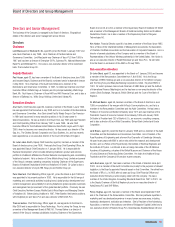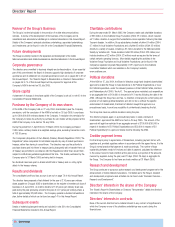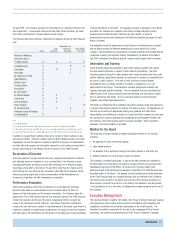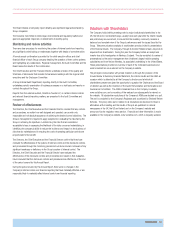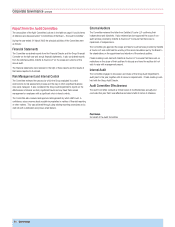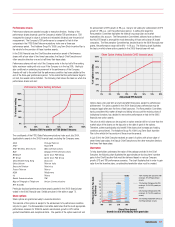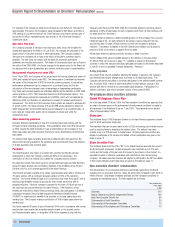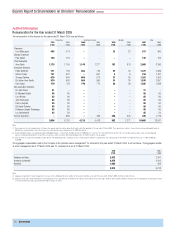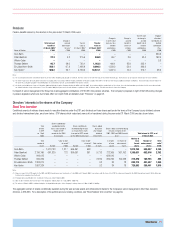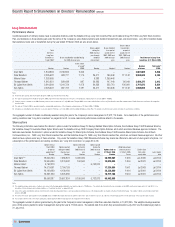Vodafone 2005 Annual Report Download - page 64
Download and view the complete annual report
Please find page 64 of the 2005 Vodafone annual report below. You can navigate through the pages in the report by either clicking on the pages listed below, or by using the keyword search tool below to find specific information within the annual report.
Corporate Governance continued
62 |Governance
plans and budgets and Group capital structure and funding. It also reviews major
acquisitions and disposals. The Integration and Operations Committee is responsible
for setting operational plans, budgets and forecasts, product and service development,
customer segmentation, managing delivery of multi-market propositions and managing
shared resources.
Committees of the Board
The standing Board committees are the Audit Committee, the Nominations and
Governance Committee and the Remuneration Committee. The composition and terms
of reference of these committees are published on the Company’s website at
www.vodafone.com. The Secretary to these standing Board Committees is the
Company Secretary or his nominee.
The Audit Committee
The Audit Committee is comprised of financially literate members having the necessary
ability and experience to understand financial statements. Solely for the purpose of
fulfilling the requirements of the Sarbanes-Oxley Act of 2002 and the Combined Code,
the Board has designated John Buchanan, who is an independent non-executive
director, as its financial expert on the Audit Committee. Further details of John
Buchanan can be found in “Directors and Senior Management”.
Under its terms of reference, the Audit Committee is required, amongst other things, to
oversee the relationship with the external auditors, to review the Company’s preliminary
results announcement, interim results and annual financial statements, to monitor
compliance with statutory and listing requirements for any exchange on which the
Company’s shares are quoted, to review the scope, extent and effectiveness of the
activity of the Group Internal Audit Department, to engage independent advisers as it
determines is necessary and to perform investigations. At least twice a year, the Audit
Committee meets separately with the external auditors and the Group Audit Director
without management being present. Further details on the overseeing of the
relationships with the external auditors can be found under “Directors Report –
Auditors”and the Report of the Audit Committee is set out on page 64.
The Nominations and Governance Committee
The Nominations and Governance Committee, which provides a formal and transparent
procedure for the appointment of new directors to the Board, generally engages
external consultants to advise on prospective Board appointees. This year, the
Committee oversaw the appointment of a new Financial Director to take over from Ken
Hydon upon his retirement and recommended the appointment of a further non-
executive director. Detailed role profiles were agreed by the Committee before external
search consultants were engaged to prepare a shortlist of potentially suitable
candidates. Only after a rigorous interview process were the appointments
recommended to the Board.
The Committee also reviewed the Group’s succession plans, directed the performance
evaluations described earlier in this Annual Report, discussed matters of corporate
governance and assessed the independence of non-executive directors prior to
reporting to the Board.
The Remuneration Committee
The Remuneration Committee is responsible to the Board for the assessment and
recommendation of policy on executive remuneration and packages for individual
executive directors. The Committee has regular private sessions without executives
present. Further information on the Committee’s activities are contained in the Board’s
Report to Shareholders on Directors’ Remuneration.
Internal Control and Disclosure Controls and
Procedures
Introduction
The Board has established procedures that implement in full the Turnbull Guidance,
“Internal Control: Guidance for Directors on the Combined Code”, for the year under
review and to the date of approval of the Annual Report. These procedures, which are
subject to regular review, provide an ongoing process for identifying, evaluating and
managing the significant risks faced by the Group.
Responsibility
The Board has overall responsibility for the system of internal control. A sound system
of internal control is designed to manage rather than eliminate the risk of failure to
achieve business objectives, and can only provide reasonable and not absolute
assurance against material misstatement or loss. The process of managing the risks
associated with social, environmental and ethical impacts is also discussed under
“Corporate Responsibility”, below.
Control structure
The Board sets the policy on internal control that is implemented by management. This
is achieved through a clearly defined operating structure with lines of responsibility and
delegated authority. The Executive Committee, chaired by the Chief Executive,
manages this on a day-to-day basis.
Written policies and procedures have been issued which clearly define the limits of
delegated authority and provide a framework for management to deal with areas of
significant business risk. These policies and procedures are reviewed and, where
necessary, updated at Executive Committee meetings.
Control environment
The Group’s operating procedures include a comprehensive system for reporting
information to the directors. This system is properly documented and regularly
reviewed.
Budgets are prepared by subsidiary management and subject to review by both
regional management and the directors. Forecasts are revised on a quarterly basis and
compared against budget. When setting budgets and forecasts, management
identifies, evaluates and reports on the potential significant business risks.
The Executive Committee and the Board review management reports on the financial
results and key operating statistics.
Emphasis is placed on the quality and abilities of the Group’s employees with
continuing education, training and development actively encouraged through a wide
variety of schemes and programmes. The Group has adopted a set of values to act as
a framework for its people to exercise judgement and make decisions on a consistent
basis.
Directors are appointed to associated undertakings and joint ventures and attend the
Board meetings and review the key financial information of those undertakings. Clear
guidance is given to those directors on the preparation that should take place before
these Board meetings and their activity at the Board meeting. It is the Group’s policy
that its auditors are appointed as auditors of associated companies and joint ventures,
where possible.
The acquisition of any business requires a rigorous analysis of the financial implications
of the acquisition and key performance figures. A sensitivity analysis takes place of the
key assumptions made in the analysis. Post investment appraisals of the Group’s
investments are conducted on a periodic and timely basis.
A Treasury Report is distributed electronically on a daily basis that reports on treasury
borrowings and investments.





